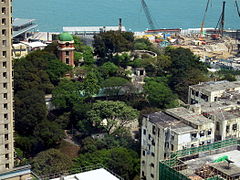Blackhead Point
| Signal Hill Garden | |
|---|---|
| 訊號山花園 | |

Aerial view
|
|
| Location | Tsim Sha Tsui, Kowloon |
| Area | 1.3 hectares |
| Opened | 1974 |
| Operated by | Leisure and Cultural Services Department |
| Open | Year round |
| Public transit access | Tsim Sha Tsui Station |
Blackhead Point (Chinese: 黑頭山; literally: "black head hill"), also known as Tai Pau Mai (大包米) indigenously, or by the names Tsim Sha Tsui Point and Signal Hill (訊號山), was a cape before any land reclamation took place in Tsim Sha Tsui, Kowloon, Hong Kong. It remains a small hill near the coast.
Blackhead Point was named after a German businessman in Hong Kong named Friedrich Johan Berthold Schwarzkopf, who naturalised as a British citizen and anglicised his name as Blackhead.
The Signal Hill Tower (訊號塔) was built in the Edwardian style in 1907 at the top of the hill. Originally three-storey building, the tower stood at 12.8 metres (42 feet) tall, with a red brick facade. Another storey was added to the structure in 1927 for clearer view of the tower from incoming vessels, this heightened it to 18.9 m (62 ft). The windows of the added storey features round windows whereas the original floors have square windows. Prior to the addition,the roof of the building was flat. A dome-shaped roof painted light green was built in replacement. There was a 5.5 m long mast which used to contain the time ball atop the building.
The purpose of the tower was to house a time ball apparatus of the Hong Kong Observatory previously located in the nearby Marine Police Headquarters Compound. The apparatus operated in the building from January 1908 to June 1933, dropping once daily from 1908 to 1920, and twice a day from 1920 to 1933. The dropping of the time ball ceased on 30 June 1933 as the building itself was in disrepair, short of staff, and the method used to check the marine chronometers had become obsolete, in comparison with radio-telegraphy and telephony. The Urban Council restored the tower in the 1970s.
...
Wikipedia
